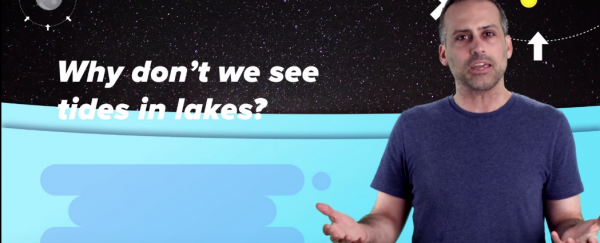A fundamental law in physics states that gravity affects all objects in exactly the same way based on their mass. We're also told that the gravity exerted by the Moon and the Sun are responsible for tides in the ocean, including when and where they occur, and how high or low they rise or fall at certain periods of the day. But if water has the same mass, then why don't lakes have tides just like the oceans? Sit back and relax, because in the latest episode of PBS Space Time astrophysicist Gabe Perez-Giz explains why everything you've learnt about tides is probably wrong.
And we're not talking about 'wrong' in the sense that what you were taught in high school was so simplified it's technically not even correct anymore. Gabe says that what we're taught as the most common scientific explanation for tides is wrong at a basic level.
What you've probably learnt is that depending on where the Moon's orbit has positioned it in relation to Earth, the gravitational pull will be strongest at the closest point on Earth to the Moon, and weakest on the opposite side. You'll often see websites or videos explain this using a very simple diagram where Point A on Earth is closest to the Moon, so it gets the strongest gravitational pull, Point B on the other side of the planet is the furthest away so it gets the weakest gravitational pull, and Point C in the middle of this so-called Earth/Moon line gets a gravitational pull that's somewhere between the two.
"The net effect of this differential of the Moon's gravity across Earth is to stretch the oceans out like taffy," says Gabe, "ergo why the oceans 'bulge out' at opposite points along the Earth/Moon line."
And as Gabe points out, that explanation makes sense, and lots of scientists have used it, but it's not correct.
But before you flip your desk over, throw your computer out the window, and start filling out one of these (on your other computer, obviously), it's not that the facts of the above explanation are wrong. There really is a gravity differential from the Moon at Points A and B on Earth, and this does cause two tidal bulges at either end of the Earth/Moon line.
"If Earth could rotate underneath those bulges with no friction between the ocean and Earth's crust, then at a given location on the globe, you would experience two high tides per day as you pass through each bulge, and two low tides per day as you pass through the spots at 90 degrees to the bulge," says Gabe.
Problem? The explanation for how those bulges actually form is wrong: they're not being formed by that gravitational differential at all. Gabe says something much more subtle is going on here, so subtle that many astronomers and scientists - himself included - have missed it for years. I'll let him explain it in the video above, because this is complicated stuff, but trust us, you're gonna feel amazing when it's all over.
